Up close with Eric Hinman
Eric Hinman is the fast age grouper who inspired Dave Mirra to pick up the sport, but he is actually fairly new to the sport himself. We checked in with him to learn more.
Slowtwitch: Thank you for your time Eric.
Eric Hinman: Thank you for reaching out to me, I am honored. I’m a huge fan of Slowtwitch!
ST: Dave Mirra spoke highly of you and said that you pretty much inspired him to pick up triathlon.
Eric: It’s really rewarding when I have friends tell me that I inspired them to start running again, compete in a triathlon, and/or live a healthier lifestyle. I think the passion I have for triathlon really resonates with people. I remember when I first met Dave, it was like pulling teeth to get him to go on a 30 minute run. I’d always tell him it was going to be easy and then I would try to extend the run without him knowing. Subsequently, he started to say “no” more often when I asked him to go for a run! After he and his family came to support me at Ironman Lake Placid in 2012, I think he was intrigued + inspired by the hard work and dedication that each person has to put in to complete an Ironman. He was hooked!

ST: But you are actually fairly new to the sport yourself.
Eric: I started competing in triathlon in 2010 – I raced two sprint triathlons that year. In 2011, I completed my first Half Ironman – Eagleman 70.3. After finishing – famished, sore, and delirious, I vowed I’d never attempt such a feat again! Two days later, I signed up for Syracuse 70.3 and also decided I would attempt a full Ironman in 2012. It’s amazing how the sport sucks you in!
ST: You dabbled in a variety of sports, what made triathlon stick – at least for now?
Eric: I enjoy the self-improvement aspect of triathlon. You’re always competing against yourself, trying to better yourself. I also enjoy the individuality of the sport – everyone has their own training plan, race plan, recovery plan, and nutrition plan. There are a million ways to skin a cat, but ultimately you have to put in the work to succeed in the sport. There are no shortcuts! I also love the community – I’ve met many of my best friends today through triathlon.
ST: I think some folks could prove to you that there are shortcuts.
Eric: Herbert, I can only tell you what’s worked for me, and it’s simply consistency, time and hard, but smart work! I tried the minimalist approach when I first entered triathlon. All of my workouts were at a hard intensity; short and sweet! Needless to say, I was getting beat. After switching to my current coach, Mike taught me about Maff training. In a one year period, I went from running 8:15’s / mile at a 140 HR to 7:15’s at a 140 HR. Fast forward to today, now I run 6:40’s at a 130 HR. 80 % of my training is at an aerobic HR. He taught me to slow down, to go fast. Unfortunately, I don’t know of any magic pills you can take to go fast on race day!
ST: Well, it is good to hear that no magic pills are involved with you at least. Sadly though that is not true for some. But back to you and your race in Galveston. I think your final time was 4:08.
Eric: Yes, it was one of those days where it all came together! I spent countless hours grinding away on my bike trainer this winter. Kudos to my girlfriend, Jill for putting up with the near-constant melody of a fan and bike tire spinning! Since October, post Ironman Kona, I’ve also learned a lot about nutrition, recovery and sleep. Putting those together with a well-structured training plan from my amazing coach, Mike Corona I’ve achieved a greater level of fitness than I ever imagined.
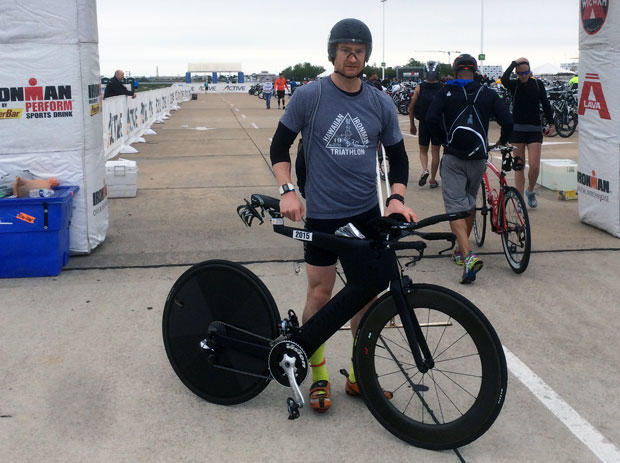
ST: Was that the fastest Half Ironman time to date for you?
Eric: Yes, previously I finished in 4:24 at Raleigh 70.3.
ST: You had very nice run and bike splits.
Eric: As mentioned, since October I have really focused on gaining bike fitness. Because of the bike fitness I was able to run well off the bike and negative split the half marathon. It was also my first time riding my Dimond bike. So much for no new gear on race day! A number of people asked me how I liked the bike, prior to the race and I exclaimed, ‘I’ll let you know based on my bike split!’ Needless to say, I love the bike! A shout out to Syracuse Bicycle for assembling and fitting me on my Dimond in such short notice, the week before the race.
ST: Were you not at all worried that something would come apart or not work properly on that newly assembled machine?
Eric: Funny you should ask, I wasn’t too concerned until I dropped my bike off at Island Bicycle in Galveston to have it reassembled two days before the race. Upon entering Island Bicycle, there weren’t any road bikes or triathlon bikes, just beach cruisers that they rented. They reassured me that they could put my Dimond together. One hour after dropping it off, they called and said it was ready. I was relieved, but anxious to ride it to make sure everything was working properly. It worked perfectly; Island Bicycle did an exceptional job! I’m one of the least handy people you’ll ever meet – they always joke with me at Syracuse bicycle when I come in for service 101, like changing a tube or tire – I tell them I just ride! Thank god, they do exceptional work, always getting my bike prepped for training + racing!
ST: How did you come upon that Dimond?
Eric: In early 2013 TJ Tollakson and Ethan Davidson reached out to me to see if I would be interested in riding their radical new prototype, the Dimond bike. I was honored to say the least. They had complications with the 2013 frame and decided to manufacture the frame in-house for 2014. My bike arrived about a month ago and as mentioned previously, my first ride on it was in Texas. I love it!
ST: And how did they know about you?
Eric: That’s a great question, I never asked! You’ll have to ask TJ! I presume they looked at AG’s with semi-fast bike splits and defined legs. I fit the bill!
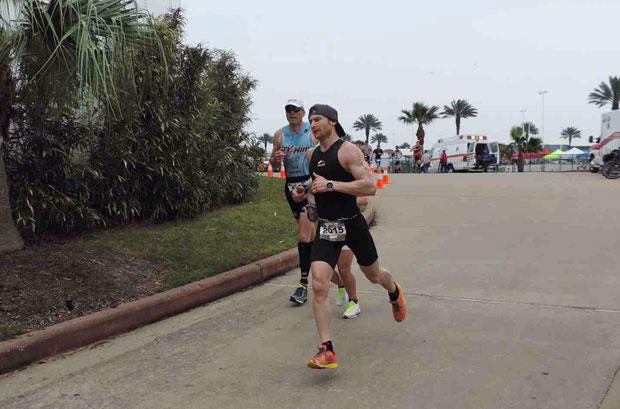
ST: Swimming seems to be the weak link. What is still possible there?
Eric: Dave didn't tell you? I swim with a band around my ankles in races to conserve my legs for the bike and run. Kidding! I had no prior experience swimming pre-triathlon. In my first race I had to backstroke and sidestroke to avoid drowning. I have put in a considerable amount of time to learn the proper technique, but still need to focus on getting more yards in each week. Swimming is the low hanging fruit to continue bettering myself at triathlon.
ST: I think swimming is the least interesting fruit for many.
Eric: It’s monotonous staring at the black line in the pool! When running and biking, you can look at the scenery, and there’s a sense of accomplishment as you cover the terrain. Plus, living in Syracuse, it’s no fun jumping into a cold pool when it’s 10 degrees outside. I’m cold the entire day. I’ve finally learned to enjoy training in the pool. For me, it’s getting into the pool 4-5 times per week to keep that “feel” for the water.
ST: You mentioned your finish at 70.3 Raleigh. Was that the first major age group victory?
Eric: Yes, that was my first AG victory. I had a horrible swim. The day before it was heavily anticipated it would be a non-wetsuit swim, the water was between 79 + 80 degrees. Magically, on race day the water was 78 degrees making it wetsuit legal. Unfortunately, my wetsuit was resting peacefully back in my hotel room. It was a tremendous mental blow knowing that I would be giving up time by not wearing a wetsuit. After getting out of the water, bummed about my time, I hammered the bike and hung on for the run.
ST: I believe you took the 70.3 Worlds slot but did not race in Vegas. At least there is no result listed.
Eric: I qualified at Raleigh last year and took the spot. However, my ultimate goal was to qualify for Kona. After qualifying for Kona at Ironman Lake Placid, I decided not to race Las Vegas. Too many away games in one year.
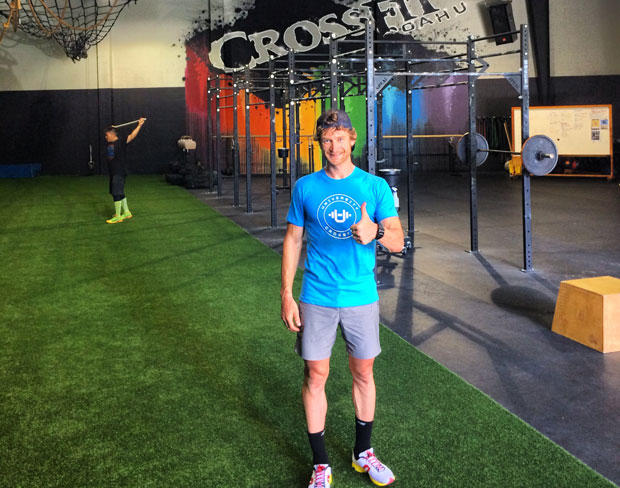
ST: So how long did you stay in Kona?
Eric: Jill and I arrived 4 days before the race – it wasn’t enough time to acclimate to the conditions. Live and learn! Subsequently, we jumped over to Honolulu after the race and stayed until the following Friday. We had a blast!
ST: And how did your race go?
Eric: Terrible race! It’s amazing how difficult a poor performance is compared to a good race. I was sick the day before the race – stomach bug. On race day, the bike leg turned into a porta-potty crawl. I couldn’t keep any of my nutrition down. It turned into a mental battle with thoughts of quitting. After realizing how lucky I was to be racing in Kona, and knowing how difficult it is for many just to finish an Ironman, I decided quitting wasn’t an option. I was determined to get my finisher’s medal and t-shirt. Also, so many people supported me along the way, I really felt like I would let them down if I didn’t finish. I crossed the line in just over 11 hours; not what I had planned, but it was rewarding to know that I didn’t give up when faced with adversity. I’ll be back this year for revenge!
ST: Your name also did not show up at 70.3 Syracuse last year. Did you just not have this 'local world championship' race on your calendar?
Eric: Last year I raced Raleigh in early-June and Ironman Lake Placid in July. The timing didn't work with the training block I wanted to put in pre-Lake Placid. I’ll be racing Syracuse this year.
ST: What is next for you in terms of racing?
Eric: I have a couple local road races and sprint triathlons, but the focus is on Syracuse 70.3 and ultimately Ironman Lake Placid in July with the goal of winning my age group and qualifying for Kona.
ST: Talk about your day job.
Eric: I own a Property and Casualty Insurance Agency. I am a partner and co-founder of Rounded, a digital agency/software development company, and co-founder and partner of Urban Life CrossFit. I do my best to balance all of my obligations by developing routines, sticking to a tight schedule, and drinking copious amounts of caffeine! It would be remiss of me not to thank my business partners and employees for allowing me the time and flexibility to pursue my passion for triathlon.

ST: How many hours do you train during the season?
Eric: I typically train 20-25 hours per week. My coach plans out my triathlon training schedule on a biweekly basis, and I sneak in 2-3 crossfit workouts per week.
ST: Is anyone mocking you about crossfit, or have you changed a few minds?
Eric: I’ve heard it all. Quit doing CrossFit! You’re going to get injured! You’re too big for triathlon, lose some muscle, you’ll run faster and won’t sink in the water! Needless to say, many of those naysayers, including my coach who initially encouraged me to give up CrossFit now do it themselves! I do CrossFit 4 – 5 times / week in the offseason (Oct – Feb), and then back off to 2-3 times week as triathlon training ramps up.
There’s not a doubt in my mind that CrossFit has helped me succeed in triathlon. It has strengthened my core and helped prevent injury. I’ve had no injuries, other than a bike crash. Full disclosure, as a newly-minted CrossFit gym owner, I’m slightly biased. I have to thank my business partners and head trainers, Jamar and Meg for their amazing programming and our awesome members at Urban Life for all of their support.
ST: Any other thoughts?
Eric: My journey in triathlon wouldn’t be nearly as enjoyable without all of my friends, family, + supporters. My girlfriend, Jill, who has kept me well-fed, put up with my demanding training schedule, and shared in my ups and downs. My parents, Charlie and Nancy, who travel to the majority of my races and can be heard (my mom yelling) and seen (my dad with his highlighter orange shirts) by all on the racecourse. My friends who’ve cheered me on, tracked me, and congratulated me post-race. My business partners for allowing me the flexibility to train and race. You guys/gals all rock!
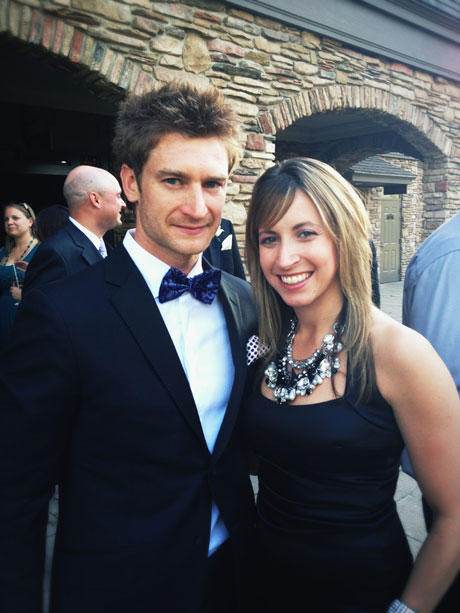


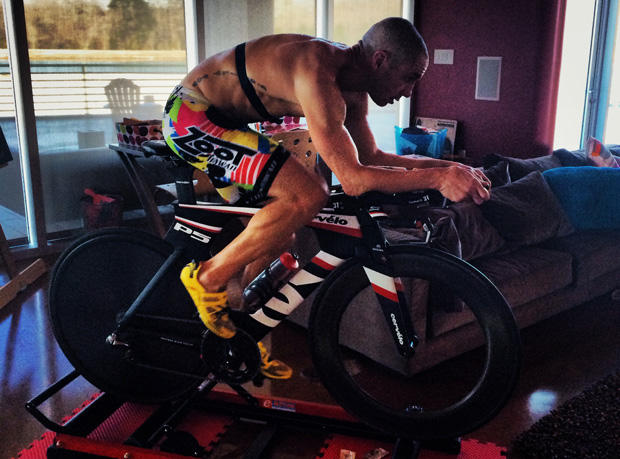
Start the discussion at slowtwitch.northend.network